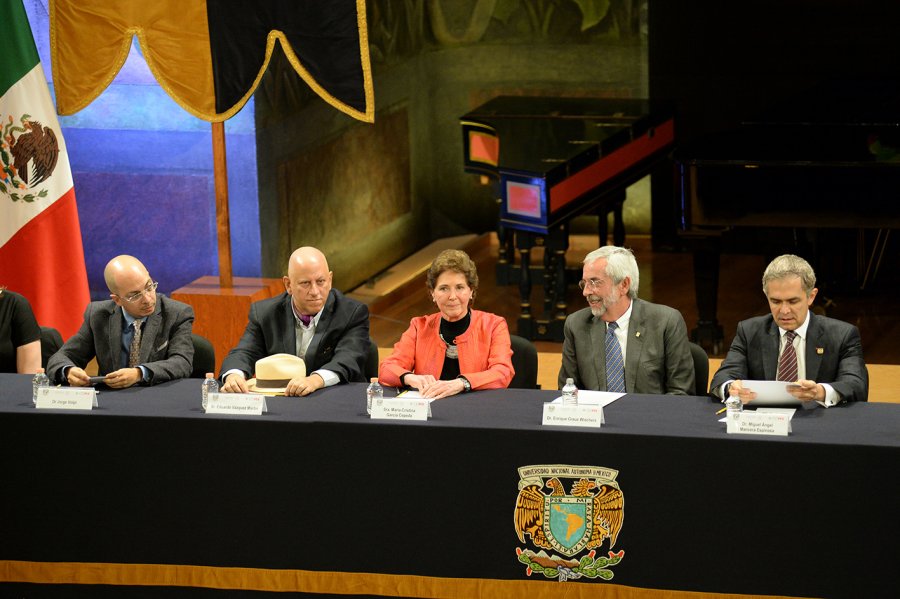Noticias
“Art is the shared homeland between countries like Mexico and the United States”: Ma. Cristina Carcía Cepeda
Opening of the exhibition Three centuries of engraving of the National Gallery of Art of Washington
February 08, 2017Over 100 artists’ works who build a tour through the graphic history of the United States and Mexico from 1710 to 2010, make up the magnificent exhibition Three centuries of engraving of the National Gallery of Art of Washington, which is on display as part of this American institution 75th anniversary and the 25th of the Old School of San Ildefonso, and was opened there on February 7th.
Secretary of Culture, María Cristina García Cepeda; rector of the UNAM, Enrique Graue Wiechers; Mexico City mayor Miguel Ángel Mancera, and Bertha Cea Echenique, executive coordinator of the Old School of San Ildefonso, led the opening ceremony of the exhibition that includes artists Jackson Pollock’s, Andy Warhol’s, Roy Lichtenstein’s, Jose Clemente Orozco’s and Diego Rivera’s works, within a wide mosaic of times, artistic trends, ideologies and events.
The head of the Secretary of Culture stated that Mexico dialogues with the world through culture, it is in dialogue where societies enrich themselves by looking in the mirror of each other to better understand their reality and value themselves basing on mutual knowledge. This exhibit ranges from the recession to the postwar period, from the protests of the sixties to later avant-gardes in the American history.
She said that this exhibition supports that art is the shared homeland between countries like Mexico and the United States, and celebrated that the collection of the National Gallery of Washington contains Mexican works that enrich even more the perspective on the great exponents of this artistic movement.
Enrique Graue Wiechers stated that Mexico and the United States share a common history with mixed and indissoluble cultures, as shown by the images of this gathering of great works that show how engraving was a vital resource for bringing art to most people in both countries.
At the ceremony were also present: US Ambassador Roberta S. Jacobson; Eduardo Vázquez Martín, secretary of Culture of Mexico City; Jorge Volpi, coordinator of Cultural Diffusion of the UNAM; Bertha Cea Echenique, executive coordinator of the Old School of San Ildefonso and curator Amy Johnston.
Miguel Ángel Mancera celebrated that this great exhibition is on display in San Ildefonso presenting historical events that build a direct bridge between the culture of Mexico and the United States endorsing their bonds of friendship.
United States ambassador Roberta Jacobson said that the engravings that make up this exhibition show key passages of independence and democracy in the United States, in addition to the works of artists like Diego Rivera who influenced many artistic movements in that nation.
"This exhibition is a reminder of the close relationship between our nations. Art goes beyond governments and allows us to remember the great cultural heritage we share”, the diplomat said.
The exhibition is divided into nine key themes: Transatlantic Exchanges, Expansion, Conflict and New Markets, Artistic Engraving, Armory Show, Looking Up, Looking Down, The Great Depression and Mass Distribution, War and Abstraction, Popular Culture and Pluralism.
During the opening tour the public was able to enjoy pieces such as Sweet dreams baby!, by Roy Lichtenstein; White Square XII, (Josef Albers, 1966); the piece in polyurethane Profile of Airflow, by Claes Oldenburg; the famous screenprint of Marilyn Monroe (Andy Warhol, 1967); Cardboard Bird by Robert Rauschenberg and the Green Picture by Richard Diebenkorn.
Other celebrated works were Hair, by Kiki Smith; Women must be naked to enter the Met Museum a picture by the Guerrilla Girls, Bo Diddley an etching by Richard Serra and Leslie a photoengraving by Chuck Close.
The exhibition Three centuries of engraving of the National Gallery of Art of Washington, is on view until April 30th in the Old School of San Ildefonso, Justo Sierra 16, Historic Center.
Mexico,Distrito Federal
